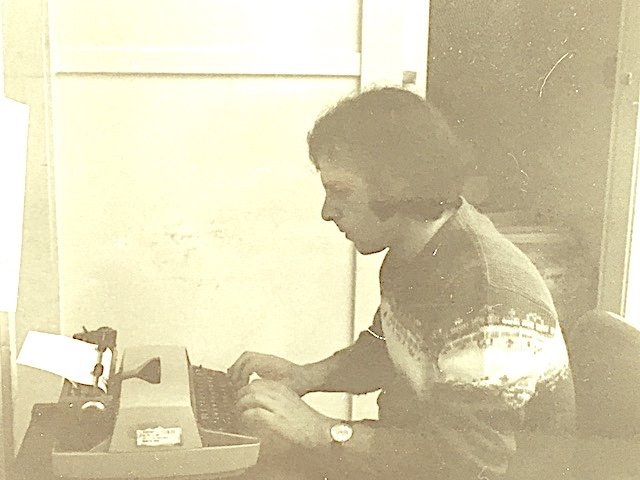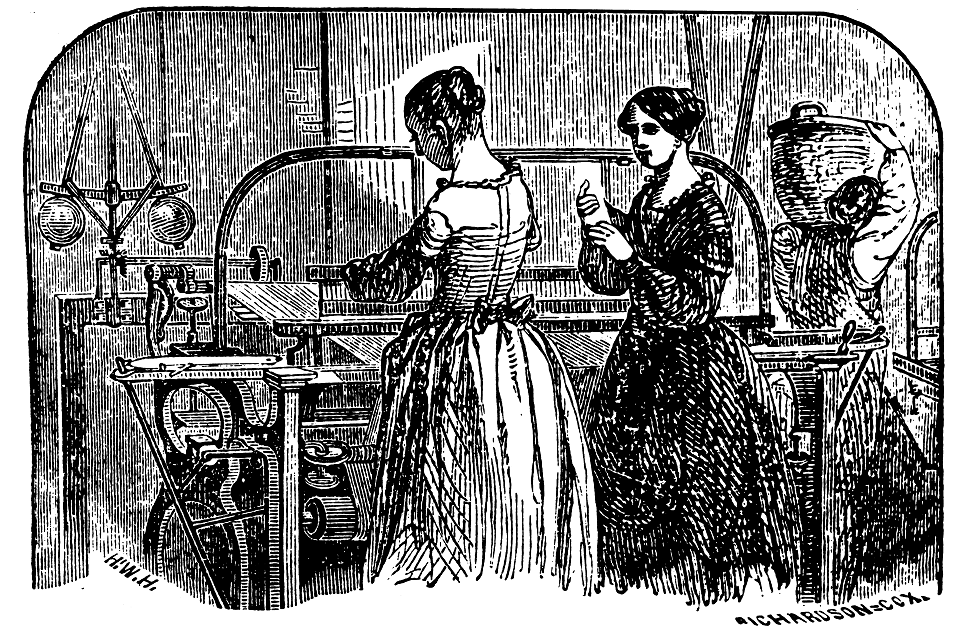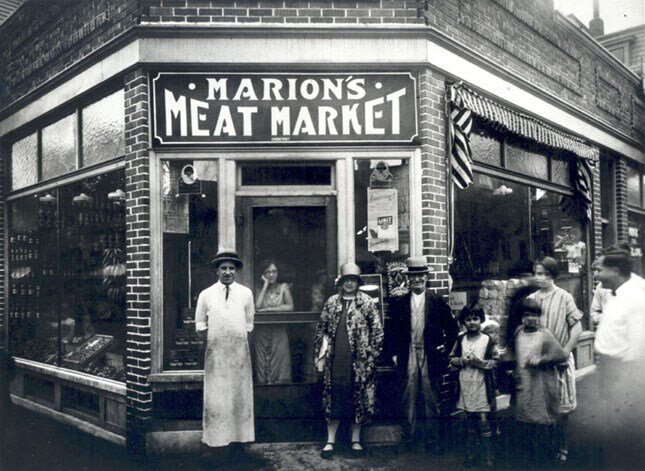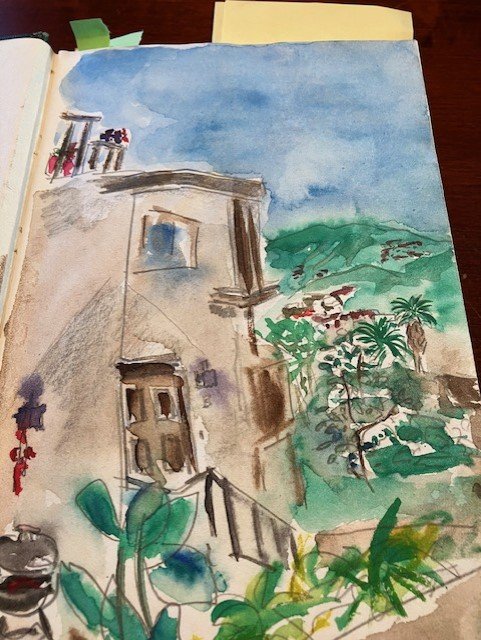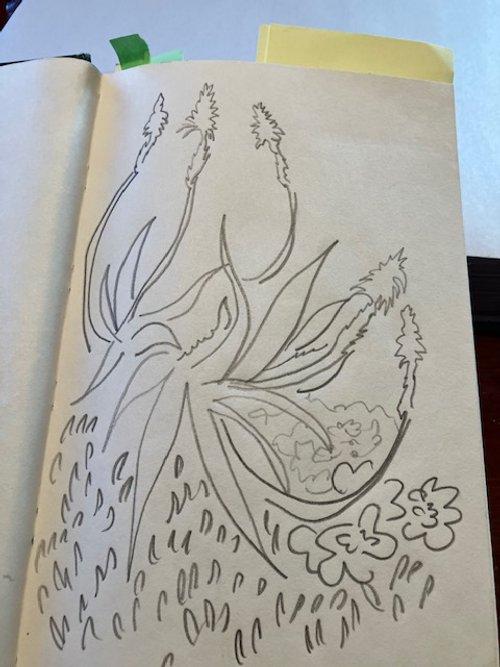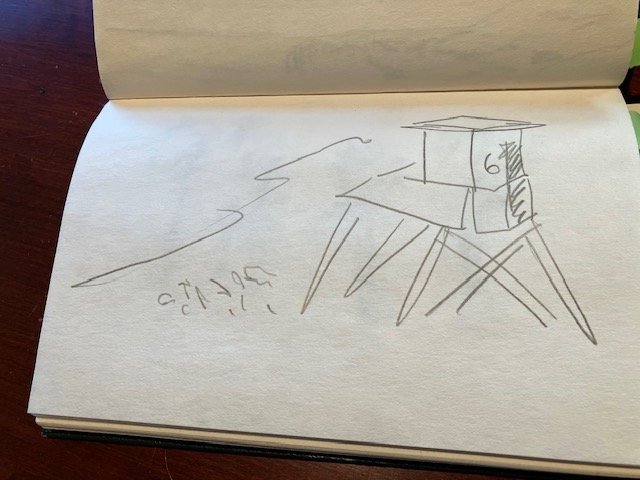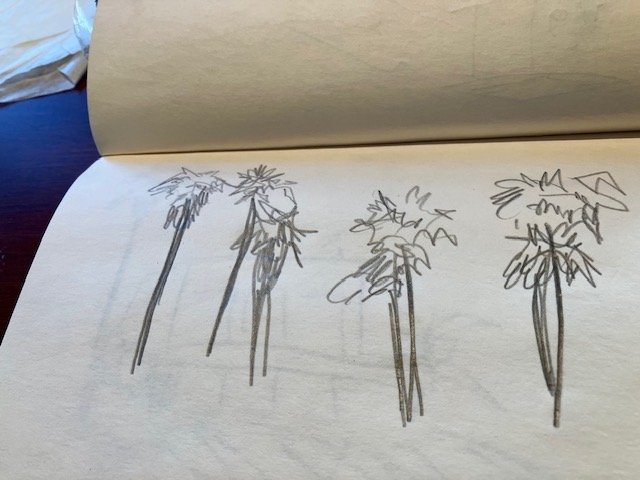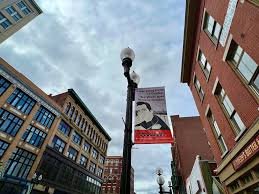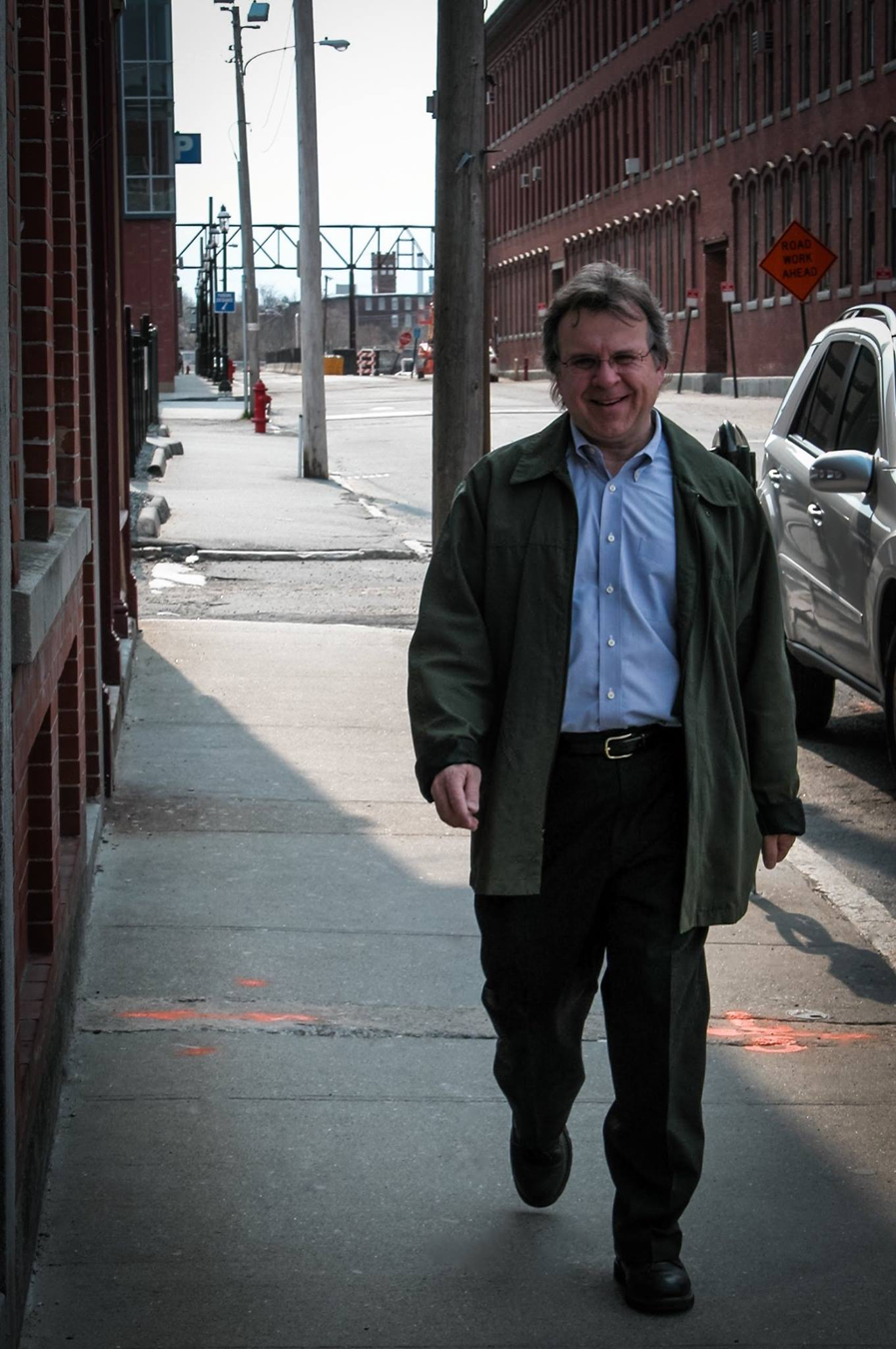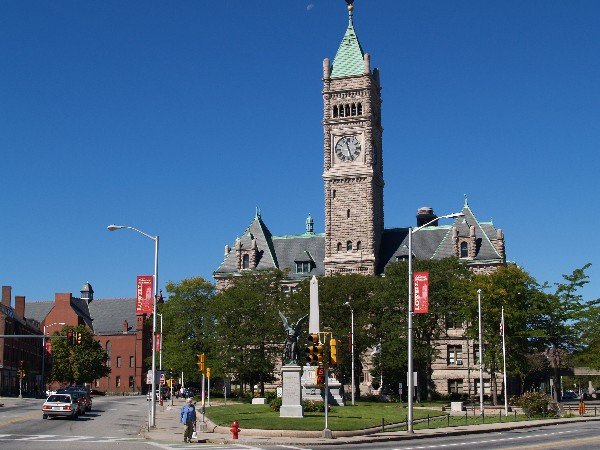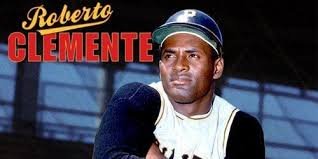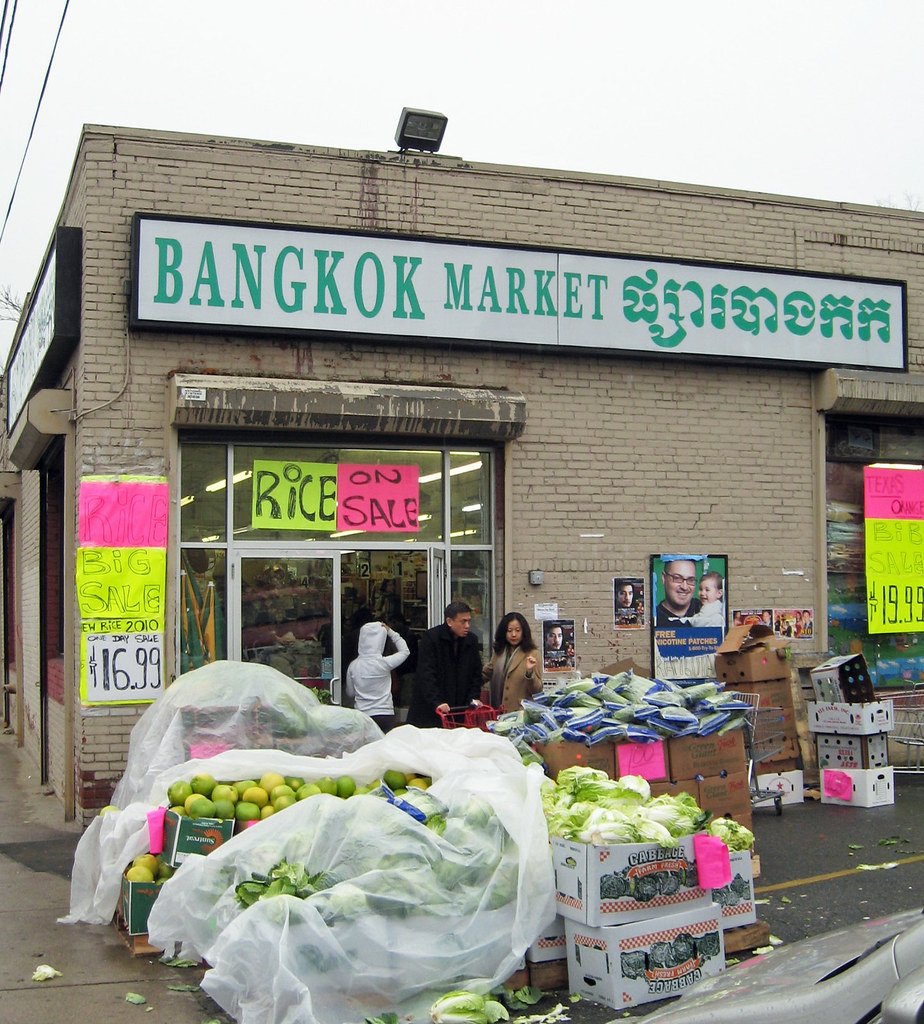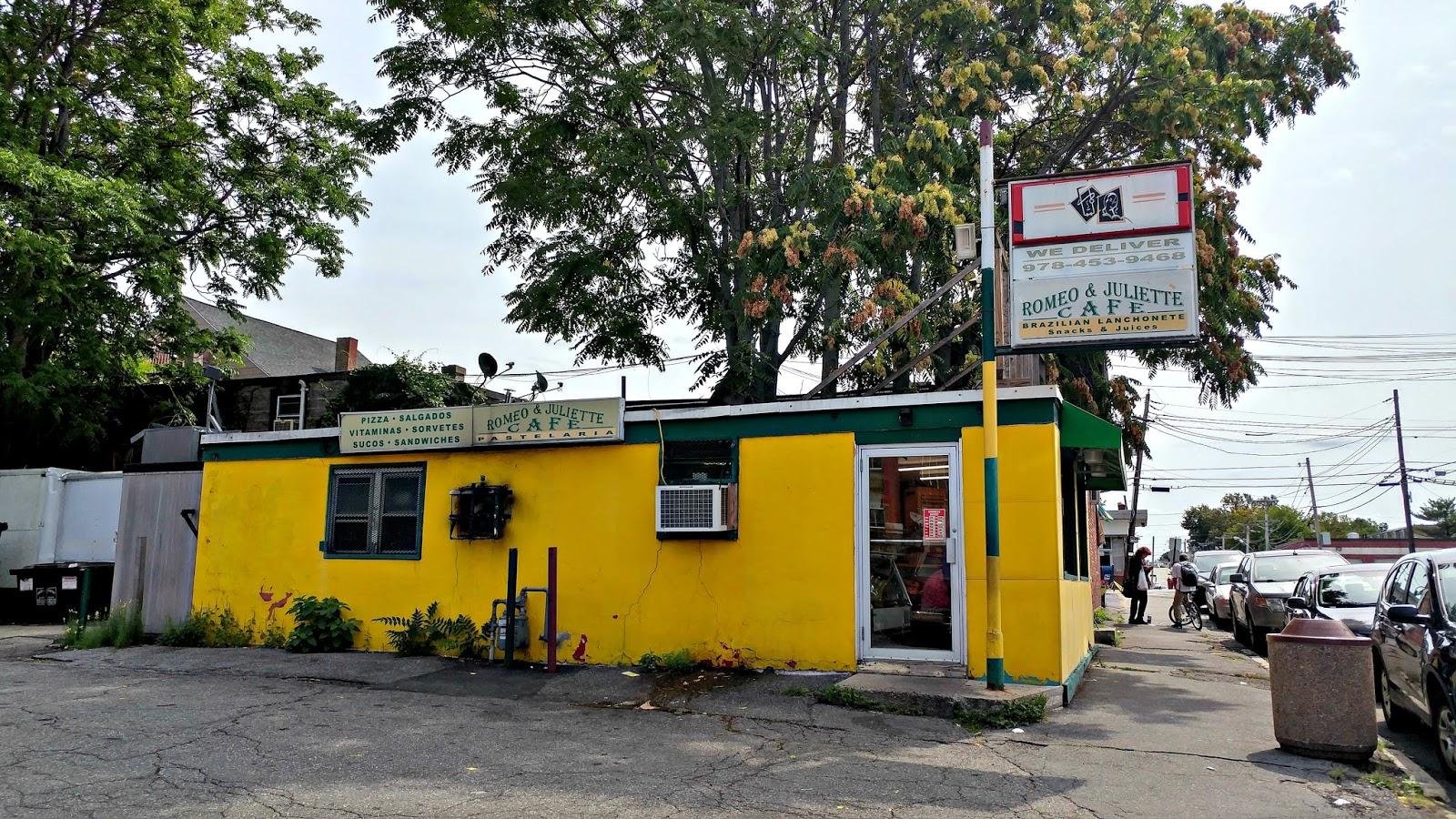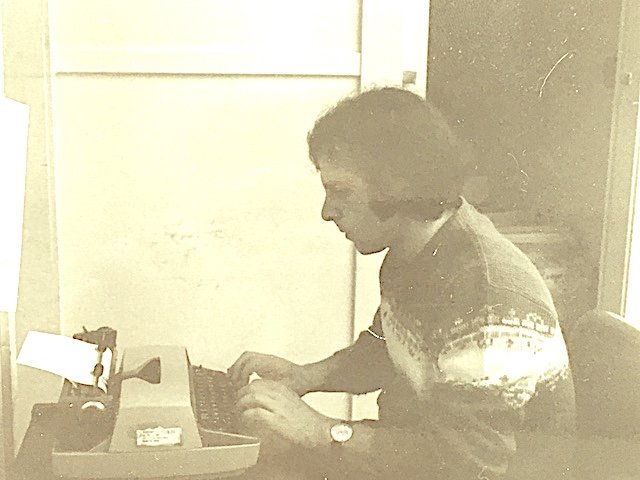Moses Greeley Parker Lectures
Keynote Address, Lowell Celebrates Kerouac! Festival
October 7, 2023
Paul Marion
“The Evolving Position of Jack Kerouac in Lowell, 1935-2023”
Thank you for the kind introduction, Mike Flynn. What a fantastic collection of human beings we have, a tremendous turnout. I’d say about 100 people are here. I think 25% of my high school class is here to help fill the seats. I want to add my thanks to Paul Lappin and the Parker Lectures, an institution in Lowell going back to 1917. The series is as vital today as it has ever been. Thank you to Lowell Celebrates Kerouac! Especially Steve Edington and Mike Flynn for the invitation. Steve also helped me with some research points, and I want to also acknowledge my old friend in Chicago John Suiter, who wrote Poets on the Peaks about Gary Snyder, Philip Whalen, and Jack Kerouac as fire lookouts in the Northwest. John turned up something I’m going to mention later that shocked me because I’ve been poking around the Kerouac story since the 1970s. This was under our noses, and yet I never knew. Maybe somebody else here will speak up when I mention it.
Steve Edington asked me to talk about the evolving position or evolving perception of Jack Kerouac in Lowell from 1950 to the present, but to fill out my argument I went back to 1930s. It’s helpful to think about it in these terms because Kerouac was known in Lowell from the middle of the 1930s.
We’re here to talk the odd arc of Kerouac’s reputation locally. Some of us earlier watched the documentary film which is national in scope, a very good job. This talk focuses on Lowell.
Not to pick on the widely known poet Billy Collins. People know Billy Collins? Yes, okay. So, not to pick on him, but he wrote a poem that he published in the 1988 that sums up the way Lowell people for a long time viewed Jack Kerouac. The poem is called “Lowell, Mass.” I didn’t know about the poem until 15 years ago when I got a photocopy in the mail from Nancy Donahue, the philanthropist whose name is on this arts center at Middlesex Community College. She sent me the poem, which appeared in Collins’ first book, published by University of Arkansas Press. Of course, now he’s Billy Collins in bold letters and published in New York City. Each of his books is a national event, as much as a poet can spark a national event. He was not a near-household name in 1988. Interestingly, he never reprinted the poem in his selected poems, collected poems, or dissected poems.
I remembered it. Lately, I’ve been co-editing an annual literary magazine called The Lowell Review. Dick Howe, Jr., who is here, is the other editor. We were collecting material for the second issue, coinciding with the Kerouac Centennial in 2022, and had a special section on Kerouac. I wrote to Billy Collins to ask if we could reprint the poem because nobody in Lowell knows that he has a poem called Lowell. He couldn’t have been a nicer guy. He sent me eight email messages from Florida, and he said he couldn’t think of a better place for the poem to be. In the poem, he puts his finger on a Lowell attitude about Kerouac and the Beat writers. His father and mother were born in Lowell in 1901. He’s from the Lowell Collins family. I don’t know if he’s related to the former vocational high school superintendent. The parents moved to New York, where Billy was born. He’s never been to Lowell, and says he would like to see the city. Maybe the festival organizers can invite him one year.
Here’s the poem.
Kerouac was born in the same town
as my father, but my father never
had time to write On the Road
let alone drive around the country
in circles.
He wrote notes for the kitchen table
and a novel of checks
and a few speeches to lullaby
businessmen after a fat lunch
and some of his writing is within
me for I house catalogues of jokes
and handbooks of advice
on horses, snow tires, women,
along with some short stories
about the deadbeats at the office,
but he was quicker to pick up
a telephone than a pen.
Like Jack, he took to drink but
beatific to him meant the Virgin Mary.
He called jazz jungle music
and we would have told Neal Cassady
to let him off at the next light.
In this poem we have the Lowell anti-Kerouac, the anti-Beat, even if it is a gentle knock and witty as is Collins’ style. The poem gives us a marker to note as we look at the bigger picture.
Before we start, I want to give an unscientific personal family story of Kerouac that is indicative of a common attitude in the 20th century. My parents were contemporaries and cultural cousins of Kerouac. My father, three years older, went to the same St. Joseph’s School as Jack did in the St. Jean Baptiste parish. My mother was one year older and with him at St. Louis School. Roger Brunelle got hold of a class list and showed it to me—there was my mother’s name, Doris Roy, and there was Jean Kerouac. I had an uncle, Bob Roy, who said he and Reggie Ouellette, Roger’s old friend who used to help with Kerouac tours, walked young Jack home from school. My mother’s youngest brother, Francis or Frank, whom everyone called Pinky because as a kid he was fascinated by a large gold pinky ring worn by a friend of the family—well, Pinky crossed paths with Jack Kerouac in Orlando, Florida, in 1961 when Pinky, a meat cutter by trade, worked in a local market. Close in age, they could have been brothers from different mothers with their thick dark hair and sparkling eyes, speaking their distinctive French learned as kids. The two guys from St. Louis parish in Lowell spoke their hometown French, and Pinky made homestyle French Canadian foods for Jack, favorites like cretons (pork spread) and blood pudding or boudin, a sausage loaf baked in a pan. I’ve never tried it.
But I grew up never hearing the name, as if Kerouac didn’t exist. Kerouac was a person in their lives, yet family members never mentioned him after he became a notable author.
My friend Paul Brouillette, who is here today, introduced me to Kerouac’s writing in 1969 when we were high school sophomores. In late October, the Lowell Sun front page carried news of Kerouac’s death. I didn’t notice. Paul saw the paper at his home and asked his parents: “Do you know this guy?” They knew who he was, not much else. His mother said Kerouac wrote books about Lowell, while his father was more direct, calling Jack a bum and a drug user. As boys they had played baseball together.
In 1970, we had a progressive history teacher at Dracut High School, Madeline McLaughlin Neilon, who introduced an elective course on Lowell and Dracut history. This was a time when things were starting to perk around the idea of rediscovering Lowell’s history, eventually leading to the creation of a national park. She tapped into that, and Kerouac was mentioned. I was still playing baseball and listening to The Beatles. When I got to college, I began reading seriously and investigating Kerouac.
I have an anecdote that illustrates a larger consciousness in the city. This story is from my wife Rosemary’s family from around 1970. Kerouac was dead, and the Lowell public library sponsored a contest of some kind for readers. Rosemary’s grandfather, an enthusiastic reader, had gone with Rosemary’s mother to Kerouac’s funeral because an important person from the city had passed way. Well, Rosemary’s grandfather, Joe Foley, longtime jewelry shop owner, won first prize at the library. He was asked to pick up his prize, which turned out to be a paperback copy of Kerouac’s Maggie Cassidy, from 1959. Mr. Foley looked at the book and asked the librarian politely, What’s second prize?
He did end up with the book, which he gave to his oldest son, Joe Foley, Jr., who had gone to Columbia University, like Kerouac, and earned a Ph.D. in English, and become a college professor. Some people think 20th-century Lowell was an abandoned lot with knucklehead ex-mill workers roaming around. No. In 1939, Kerouac was admitted to Columbia (doing a year of prep school first). Other Lowell High grads went to Harvard and MIT as well as the two colleges in Lowell. There was a professional class in the city, not large, but noticed in a city of more than 100,000 people. It doesn’t mean that it was automatic that a writer like Kerouac would have a built-in readership at home. I’ll talk about that later.
The first “tranche” in my segments of Kerouac’s life covers 1938 to 1949, and is labeled “Local Jock Makes Good.”
It’s interesting to think that young Kerouac was shy, according to interviews. However, in 1935 he wrote an ad or notice for the newspaper challenging other neighborhood teams to a football game. He’s 13 years old, and his gang wants to tackle another team. He thinks, “Okay, I’m a writer,” and he does it. This would not seem strange to a boy who grew up around his dad’s print shop, seeing words going onto paper. Plus, his dad had his own little newspaper, The Spotlight. (If anyone has seen copies of this paper, please let me know.)
Of course, sports is a path for working-class boys and girls, a way to be active in the community. Sports is a way to distinguish yourself. Kerouac was a joiner. He played in the neighborhood on Dracut Tigers field in East Pawtucketville close to the Dracut town line, which he describes in a couple of books. He also tried out and made a team in a baseball league called the Twilight League, whose games drew large crowds to the North Common and other fields.
I found a box score of one game in the newspaper, just like a detailed Red Sox box score, from 1938, a double-header in a sense that Kerouac’s A&P Grocery Store team played against two different teams in one day. Jack stole a base in each game, the speedy Jack, which would be seen again in his triumphs in high school track meets and on the football field. He has a spectacular moment in the Thanksgiving Day game against Lawrence High in 1938. As if a switch turns on, he’s a local hero instantly, scoring the winning touchdown with thousands of people cheering.
In those days local sports were heavily covered by the press. Athletes were minor celebrities. When Jack has a birthday party in March 1939, turning 17, there are photographs in the newspaper with his crew and girlfriend Mary Carney lined up at the house party. Here’s a side note on that event. In the 1970s, someone I knew went to the Lowell public library to see a copy of the paper from that day because he wanted to identify the model for Kerouac’s Maggie Cassidy girlfriend. This person got to the room where the hard copies of newspapers were kept. He found the paper of the day, opened to the Society section, and there was a big hole in the page. Somebody had cut out the photograph.
Sports was the springboard for Kerouac to go beyond Lowell when he is awarded an athletic scholarship to Columbia. He always protested that he received an academic scholarship. Remember, though, he was required to do a year at the Horace Mann School to prepare for Columbia.
At that point it’s 1939. He’s grown up in Lowell, completed high school, been accepted to college, and become a known person with a public profile that is positive, a local boy who is succeeding. In the 1940s, he is either in Lowell part-time or gone from the city. He’s back for a couple of summers in the early ‘40s and then away in the Merchant Marine or with his family closer to New York. His last stretch in Lowell until returning to live in 1967 is early 1943 when the family is living in the Pawtucketville neighborhood. From there, it’s the failed stint in the U. S. Navy and then to New York with his parents. He meets the future Beat writers in 1944 and begins the phase of his life on the road. He finishes his first novel, the family saga The Town and the City, and is offered a publishing contract by Harcourt in New York. The book is released in early 1950, and Kerouac makes plans to sign books at an event in Lowell.
The next segment in my look at Kerouac’s position is Lowell is 1950 to 1970, which I call “Kerouac in the Margin.”
Kerouac returns, a conquering literary hero, with a fat novel that will be reviewed around the country but will not sell many copies. Nevertheless, the Lowell Sun, urged by editor Charles Sampas, always a booster of Jack’s, gets behind the book and features the novel in its Sunday magazine. Kerouac signed books at the classiest department store downtown, Bon Marché, meaning “a good deal.” I can’t name another Lowell person who published a book with a New York publisher in the 20th century before Kerouac. He’s 28 years old. This is a big achievement. A golden boy football star and literary success.
For Kerouac in Lowell it’s only a decline in status from there. By the 1960s, the consensus, at least by anecdotal reports, is that he is a worthless bum whose moral values are not welcomed in Lowell. He’s lumped into the beatnik crowd and considered antisocial. How did this happen?
I’m wrestling with something I had not thought hard about. He wasn't present in the city and not many local people were reading his books, from On the Road and The Dharma Bums to Doctor Sax, Visions of Gerard, and The Subterraneans. Local folks were not reading the avant guarde prose works. The people in Scranton, Pa., were not reading them either. It was different in Greenwich Village, Harvard Square, North Beach in San Francisco, and other spots where the cultural frontier was opening up. Younger, freewheeling readers were choosing Kerouac books and stashing The Dharma Bums in their backpacks. It’s a false test to say Lowell people should have been reading Big Sur and the chorus poems of Mexico City Blues.
The exception in Lowell appears to have been Maggie Cassidy, published in 1959. In his regular blog-like free-association column in the Lowell Sun, Charles Sampas dropped a tidbit: 200 copies of the novel had sold in a bookstore on Merrimack Street. Any writer would be thrilled with that response in his hometown. This makes sense because the story is set in Lowell High School. This puts the lie to the truism that Lowell people didn’t care for Kerouac’s books. In general, though, after The Town and the City, his books were ignored. I haven’t found evidence that any book was reviewed in the local paper, a legitimate review. For sure, in Lowell there were always cab drivers, cool cats like teenage trombone player John Leite, and budding artists like Ed Adler at Lowell Technological Institute who tracked Kerouac in real time.
There wasn’t a countervailing narrative about the significance of Kerouac while he was in play. He was out of the local public eye from 1950 until 1957 when On the Road lit the literary sky with its fireworks, at least nationally. The other dozen books from 1950 to 1967 didn’t much register in the local consciousness. Over at Lowell Tech, Prof. Charles Jarvis was teaching On the Road and other titles in the English Department. In 1962, Jarvis and colleague attorney Jim Curtis hosted Kerouac on their weekly radio show on WCAP where they discussed books. Jack said, “In my opinion Lowell, Massachusetts, is now the most interesting city in the United States of America.” Maybe he felt that way because he had written so much about it.
It makes me wonder because one reads comments in news articles, random persons with negative views of Kerouac. Was he not on people’s minds in those years between 1950 and 1967? A reporter here and there would ask somebody in a barber shop and get a response like “Oh, Kerouac, he’s a drunk, he’s a bum.” He wasn’t even around.
Louis Menand, in his 2021 book The Free World: Art and Thought in the Cold War, takes up this question of views of the Beat writers. Menand is a professor at Harvard University who has been to UMass Lowell to discuss the Beat writers. He’s favorable to the Beats and questions why literary critics of Kerouac’s time and political commentators seemed to have been so threatened by the Beat writers. The denunciations were fierce. Menand sidesteps recent disapproval among critics and readers about the way the Beat writers treated women in their lives and portrayed women characters in books.
Here’s what he writes:
“The constantly iterated claim that [Kerouac] and Ginsberg were rebels and hedonists, prone to crime and violence—or that they presented themselves as spokespersons for people like that—is such a crude misreading that it is hard not to speculate about why some people found the Beats and their books so threatening. The sadness that soaks through Kerouac’s story comes from the certainty that the world of hoboes and migrant workers and joyriders—the world of Neal Cassady and his derelict father—is dying.
“. . . .The characters can’t settle down. But they want to settle down. They are not sociopaths or rebels. Their crimes against the establishment consist of speeding, shoplifting, and a minor bout of car stealing (a little illegal drug use, too). They fear and dislike cops, as people without money do; other than that, they are not especially antisocial. There is nothing like a critique of middle-class life in On the Road—or, for that matter, in “Howl.”
“The characters in On the Road are not hipsters, either, cats too cool for life in suits. There is nothing cool about Dean or Carlo Marx (the Ginsberg character): Karl converted into a Marx Brother). . . . They are misfits. This is what the “best minds” section of Howl is saying. The book is not really about sexuality. It has a slightly different subject, which is masculinity. . . . [Kerouac] was not a macho anti-aesthete. He was a poet and a failed mystic.
“. . . The Beats were men who wrote about their feelings.”
This is a very different response to the typical take on Kerouac, and I wonder about the cultural elites, literary critics and political opinion columnists—did their views seep into the consciousness of people in places like Lowell where some people read TIME magazine and the New York Times, following the national news and cultural gossip.? In Lowell, there were occasional columns by Charles and Mary Sampas, always faithful supporters of Jack. But did the national trashing of the Beats, the smearing of them as barbarians at the gate—did that seep into the consciousness of people who were not otherwise paying a lot of attention? They were busy with their own lives and responsibilities.
Why did Kerouac get such a bad rap for a long time? A couple of months ago, I said to my wife Rosemary, “He was a blow-in. The Kerouacs were blow-ins. Was that why it was easy to trash him in Lowell? People who are not from Lowell won’t know this term that is used to describe people who are not born Lowellians or have not been here for generations. It’s a pejorative term. A put down.
Even though Kerouac was born in Lowell, the Kerouacs were not Lowell people. They were Nashua, New Hampshire, people. Steve Edington has documented this in a book, Kerouac’s Nashua Connection. Jack’s parents immigrated to America as kids from Québec. Some 900,000 Québeckers crossed the border into the towns and cities along the Merrimack and Connecticut rivers after the American Civil War, looking for jobs.. Kerouac’s family stopped in Nashua, about 20 minutes north of Lowell by car.
It’s an occupational coincidence that Leo Kerouac wound up in Lowell. He was sent from Nashua to work on the French-language newspaper that Louise Peloquin’s grandfather, Louis Biron, published in Nashua. Louise is here today. The newspaper, L’Étoile, was a substantial publication whose contributors included novelists and poets. Leo came to Lowell around 1910. He was in a relationship with Gabrielle L’Évesque of Nashua. They got married in 1915 and settled in Lowell.
My ancestors on both sides, the Roys and Marions, came to Lowell in 1880. In those days, people were having six or eight or more kids. By 1915, there were a zillion Marions and Roys in Lowell. We had a large network of relatives, people who could have your back in a difficult situation. The Kerouacs had almost nobody, well, one brother of Leo’s with two sons, one of whom, Hervé, played on the A&P baseball team. Jack was from Lowell, authentically, but the connection was an inch deep. In the end, he showed a lot of love for Lowell in his books and in his life, but the feeling was not reciprocated in the community after 1950—until he had passed away. Without much of a support system, the gossip in the barbershop and tavern was mostly unanswered. If someone said, Kerouac is worthless, who stuck up for him? Yes, he had friends from his growing up time and the Sampases who were loyal, but that’s different from having a tribe of Kerouacs in the city. It was a new way for me to think about Kerouac. Could this have led to the enduring negative view of him locally?
And maybe something else was going on. Envy. The working-class residents of Lowell are proud people. Were they bothered that Kerouac and his parents left for New York City and the wider world? He got a ticket out. And then when he fell back down to earth with drinking problems and public rebukes from the literary establishment, did some people think, “See, he’s no better than us. He thought he was too good for us.” Many in Lowell would also have known that Kerouac didn’t serve in the military in World War II, another element in his unconventional resume. However, he was brave enough to sign on for Merchant Marine voyages in the North Atlantic at a time when Nazi submarines were blasting the hulls of cargo ships.
Now, fast forward to 1967 when he comes back to Lowell with his wife, Stella, and sickly mother. He’s in rough shape from alcohol abuse when they move into a suburban-style home on Sanders Avenue. And he didn’t do himself any favors. There are dozens of stories of him being loaded, out of control; behaving badly at Lowell High when a substitute teacher invited him to a class; even arrested a few times. The police repeated stories about his antics. These episodes really colored the view of Kerouac in the city. These stuck around until the narrative began to change in the 1970s.
Our next “tranche” in the segmented look at Kerouac in Lowell is 1971 to 1987, which I call “Grassroots Hero.”
Things begin to shift for Kerouac in the early 1970s. The view of the author starts to improve. It isn’t an organized effort by any means. The young generation notices him and takes steps that would refresh his local reputation up through the 1980s.
One of the things I want to mention today is that I learned the first public tribute to Jack Kerouac was in the basement of a halfway house for people with addiction problems on upper Merrimack Street, not far from St. Jean Baptiste church. The place was called Anabasis House. In 1971, community activists, probably two-thirds of them from outside of Lowell, established the Jack Kerouac Free School.
The teachers included students and faculty from Brandeis, Harvard, Lowell Tech, and Boston University, feminists from Concord and Cambridge, high school teachers in the area, and Lowell residents like Bob Malovich, a city planner. They organized the Jack Kerouac Free School, offering courses to anyone, from high school dropouts, Vietnam veterans, mothers at home, and people without jobs to lots of curious lifelong learners. Math, yoga, creative writing, childcare, Utopian society, English as a Second Language, “The Short Arm of the Law,” American history, Black history, existentialism, environmental science—the array of courses was impressive. Day care was available.
The effort flowed from the teach-ins of the 1960s, which were offered on college campuses and in community settings to raise the public consciousness about the Civil Rights struggle, the push for more equal rights for women, gay rights, and the anti-war movement opposing the Vietnam War. From the teach-ins came the free-school movement around the country. People took education into their own hands and shared what they knew in open settings.
In Lowell, community activists found a home in the basement of Anabasis House. The Lowell Sun was interested enough in this phenomenon to publish three articles with photos. I had never heard of this. The leaders named the free school for Kerouac because, they told the Sun, Lowell had not recognized the author who was so identified with a liberated mind. They acknowledged that he had damaged himself through substance abuse. He was a lifelong learner and autodidact himself going back to his skipping school and spending hours at the Lowell library. The lesson in this discovery, for me, is that there are still details we don’t know about the Kerouac subject even if they are right under our noses.
In 1973, Jay McHale, an English Department professor at Salem State College, organized the first academic symposium on the Beat writers. A Lowell High School graduate and talented baseball player, Jay invited the best-known Beats including Ginsberg and Gregory Corso to take the temperature of the culture and assess their impact as authors. The proceedings of the gathering were later published.
Also in 1973, Charles Jarvis, whom I mentioned earlier, published a biography titled Visions of Kerouac, which drew a lot of attention in the city. His book followed the first biography of Kerouac, written by Ann Charters and released by the book-publishing arm of Rolling Stone magazine earlier that year. Jarvis’s book was sold in the popular Demoulas supermarkets around Lowell because he was friends with the owner of the chain, the forerunner to Market Basket stores. Near the cash registers were stacks of books with Kerouac’s face on the cover. This was something new.
For me, the most significant happening of that period was Bob Dylan landing in Lowell with his Rolling Thunder Revue in November 1975. There was only one reason Dylan came to Lowell—to pay respect to Kerouac, who had influenced him as a young writer. A lot of you have seen the photographs of Dylan and Ginsberg at Kerouac’s grave. There’s film on YouTube that you can find in about ten seconds. That was a big deal and brought national attention. There was a spread in Rolling Stone magazine, color pictures of Dylan standing under the cross at the Our Lady of Lourdes Grotto behind the Franco-American School. Regarding Kerouac’s public profile, some Kerouac followers point to the impact of the 1982 gathering in Boulder, Colo., to celebrate the 25th anniversary of On the Road, which garnered national attention. I put my money on Bob Dylan’s visit to Lowell as a catalyst.
In 1978 things started to happen in the city, and almost every year for the next 10 years there was a Kerouac event of some kind. The Lowell Museum, which operated for a time out of the Wannalancit Mills on Suffolk Street organized a Jack Kerouac Night with the encouragement of Stella Kerouac. Twenty-something hot-shot history guys Lew Karabatsos and Bob McLeod produced the event. Some 200 people packed the museum space, with another 50 waiting on the sidewalk to get in. Those outside banged on the windows, asking to be let in. The Fire Chief had to stop by to explain that the building was at capacity for people due to the fire laws. The program included speakers, a display of foreign editions of Jack’s books, and the playing of a recording of the author reading from one of his books. This was strong proof of local interest in Kerouac.
In 1980, Susan Kapuscinski Gaylord, president of the Art Alive! co-op on Merrimack Street, with other members put together another Kerouac night at their gallery. At the co-op, dozens of painters, crafts-makers, photographers, and writers had banded together, the leading edge of a new creative economy in the city, long before that term was trending. Again, close to 200 people showed up to see Kerouac-themed artwork, hear guest speakers and poets, and listen to audio tapes of Kerouac. The following year, Art Alive! was at it again, this time hosting a marathon reading of Doctor Sax with dozens of readers taking sections all day and into the night, sitting in a living room chair set up in the glassed-in storefront on the main street.
After the live events at the start of the decade, community organizer Charlie Gargiulo collaborated with the public library staff to obtain a cultural grant from the Lowell Historic Preservation Commission (LHPC) to produce a large format, folded guide to Kerouac’s Lowell with a map marked with key sites and an essay about the author. This kept the momentum going. Soon after, filmmaker John Antonelli, based in California but a native of Greater Lowell, got himself a Preservation Commission cultural grant to develop a script for a docu-drama, a documentary film with some scenes with actors, about Kerouac’s life. When it was finished in the mid-1980s, the Merrimack Repertory Theater hosted two sold-out showings (300-plus people) of the film on the same night that it premiered at the Orson Welles Theater in Cambridge.
In 1985, Brian Foye, who is here this afternoon, and a group of allies formed a non-profit organization called the Corporation for the Celebration of Jack Kerouac in Lowell, whose purpose was to advance the appreciation of Kerouac through various means. The board members included a former city manager of Lowell, William Taupier, and journalist Mary Sampas of the Sun. The name was later shortened to Lowell Celebrates Kerouac!, the group hosting this event. On St. Patrick’s Day in 1986, Brian organized a benefit reading for the new organization with Allen Ginsberg and Gregory Corso topping the bill. Again, the venue was sold out. Many of the older Franco-American women in attendance enjoyed the idea of paying tribute to Kerouac on St. Patrick’s Day. Corso surprised the audience when he removed his teeth and put them on the stage before reading from his long poetic tribute to Kerouac, “Elegiac Feelings American.”
A delegation of Kerouac advocates, writers, and artists traveled to Québec City in 1987 for the first international gathering and conference about Kerouac. This was a benchmark event and solidified an emerging international character to things Kerouac in Lowell. Roger Brunelle especially had brokered the relationship with writers, scholars, and musicians in Montréal and Québec City. As the primary, French-speaking ambassador for Kerouac in Lowell, Roger played a critical role above and beyond being the person who invented guided tours of Kerouac places in the city. From the 1980s until his passing a few years ago, Roger led hundreds of these tours, offering a half-dozen themed walks or bus tours to local, national, and global participants. At one point, Roger persuaded the Franco-American Week Committee to host an evening program about Kerouac which was attended by Mrs. Stella Kerouac.
And so the “Beat” went on through 1987 when a decision was made to develop a permanent, outdoor tribute of some kind to Kerouac, which finally took form in the Jack Kerouac Commemorative in Kerouac Park on Bridge Street. This significant undertaking emerged from the larger Lowell Public Art Collection project led by then-U.S. Senator Paul Tsongas of Lowell. He had been pushing city leaders to commission monumental artworks for the city, the kind of sculpture he admired in Washington, D.C.—at the amazing rate of one each year.

